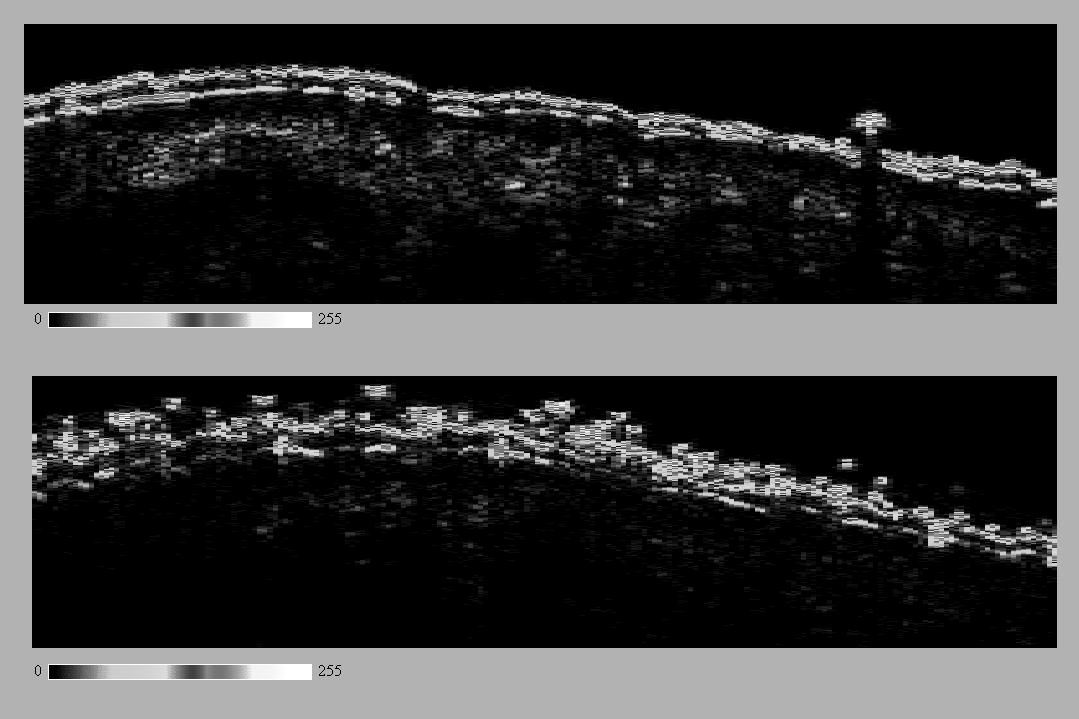New Technology Poster Session
| INABIS '98 Home Page | Your Session | Symposia & Poster Sessions | Plenary Sessions | Exhibitors' Foyer | Personal Itinerary | New Search |
Introduction
The aim of this study is to objectify the effect of physical and chemical substances on the appearance of the stratum corneum of the finger pads.
Materials and Methods
50 MHz-Sonography
The 50 MHz ultrasound imaging unit consists of an applicator with the transducer, a transient recorder, a control unit and a computer.
The 50 MHz PVDF-transducer has a mean frequency of 53 MHz, a band-width of 55 MHz, an axial resolution of 11 Ám and a lateral resolution of 54 Ám.
The images were recorded using B/D-Scan technology.
B/D-Scan
To account for the short depth of the focal area of the 100 MHz transducer a suitable imaging conception, the B/D(Brightness/Depth)-Scan concept is used.
A couple of "short" B-Scans is acquired at different depths of the tissue by mechanical movement of the transducer with respect to the depth direction (D-axis) between each acquisition.
Finally all scans are composed to get an image with a larger size. We call this additional axial motion "D-Scan" and thus, the whole procedure "B/D-Scan".
Applicator
Water is used as coupling medium.
After placing the applicator on the skin, the plexiglas chamber is filled with water.
Three stepper motors are housed in the applicator which enable a precise movement of the transducer in all three axes.
Study design
The study population consisted of 26 persons (20 men, 6 women).
Sonographic measurements were made on the finger pads with a 50 MHz unit.
After having recorded reference sonograms prior to the experiment, the finger pads of the volunteers were subjected to the following experimental situations:
- cooling
- heating
- stimulation of sweat production
- swelling of the skin
- application of acetone (drying)
- application of adhesives
- tape stripping
- sanding.
Evaluation
The evaluation of the sonograms was made by image analysis methods.
Results
A comparison of the reference values and test values obtained in the 26 subjects revealed great interindividual differences allowing to subdivide the total population into 4 groups, which differ in the thickness of stratum corneum (below 100 Ám; 100-200 Ám; 200-300 Ám; above 300 Ám).
In the figures 1-4 the upper sonogram (10 mm x 1.6 mm) presents the fingerpad before treatment and
the lower sonogram(10 mm x 1.6 mm) after treatment.
The echogenicity of the skin entry echo was:
- increased after 5 minutes of cooling;
- increased after 2 minutes of drying (Figure 1);
- decreased after 5 minutes of heating;
- decreased after 30 minutes of stimulation of sweat production (Figure 2) and
- increased after application of water unsoluble adhesive.

Figure 1: Drying with acetone.

Figure 2: Stimulation of sweat production.
The stratum corneum thickness was:
- increased after 30 minutes of stimulation of sweat production (Figure 2);
- decreased after 400 tape stripping and sanding (Figure 3).

Figure 3: Sanding.
The skin entry echo was interrupted after sanding (Figure 3). Clinical inspection revealed that the papillary body was opened.
It is remarkable, that the dissolution of the water soluble glue could be observed (Figure 4).

Figure 4: Dissolution of water soluble glue.
Discussion and Conclusion
Our results show that, when standard settings are used, it is possible to objectively assess the effect of different physical and chemical agents acting on the horny layer using sonograms.
On the one hand these agents influence the sonographic appearence of the skin.
On the other hand it is possible to take advantage of these influences by pretreatment of skin conditions prior to sonography.
| Discussion Board | Previous Page | Your Poster Session |